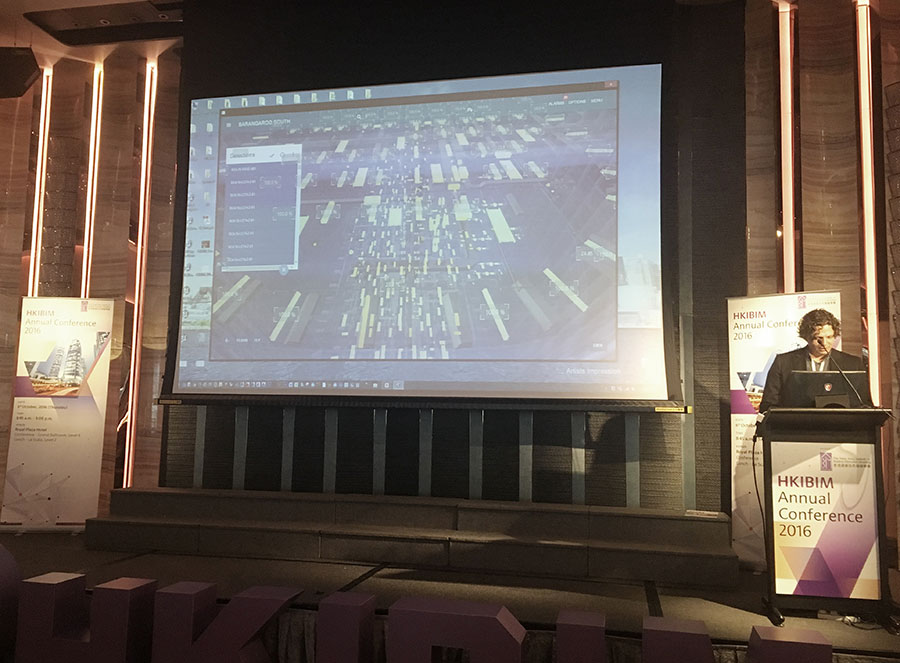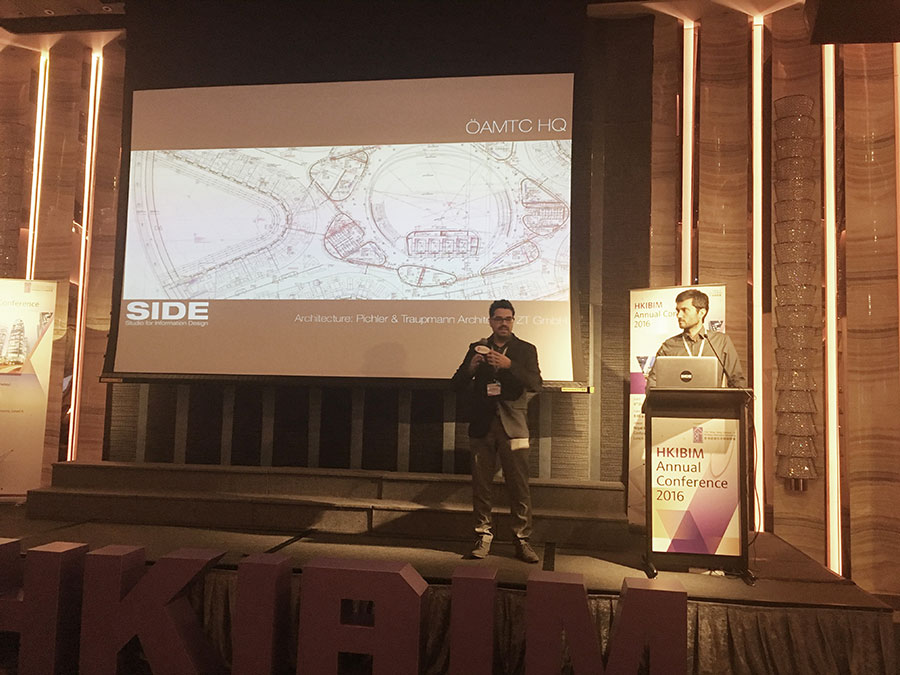
HKIBIM CONFERENCE 2016
Last week on the 6th of October took place the 2016 HKIBIM conference. This time we had the privilege to assist both as audience and speakers. Once per year the HKIBIM celebrates this event in order to summarize important milestones and case studies regarding the use of BIM in the AEC Industry in Hong Kong. Personally I am very happy to see some local examples of professionals and companies talking about BIM as a reality in their own work, and be able share with them similar challenges and experiences. But to be completely sincere, Hong Kong is still behind in terms of BIM implementation in my opinion..
What is happening outside Hong Kong in terms of BIM? Is good to be updated, right? We know that some countries like Japan, Australia and many others in Europe (Norway, Denmark, Austria, UK, etc..) are great examples of the industry embracing BIM as well as other new technologies and methods.

Mr Jeremy Harkins from Ineni Realtime.
PROJECTS DEVELOPED IN A BIM ENVIRONMENT
This year we had two guests from Austria: Mr Erich Kotroczo and Mr Christof Degendorfer from Side, Studio for Information Design. They presented some impressive case study of big Architectural projects in which the architects and engineers involved benefit from collaborating in a BIM environment. The implementation of BIM on the development of the project happened in the design stage and kept through the development and construction phase, also looking to the building management during its life cycle. It was an impressive example to see in real life projects the benefit of a successful BIM implementation process.
From Australia Mr Chris Lock from Steensen Varming joined the conference once again showing another case study of the Point Cloud Scanning for project’s survey. How this technology implemented on the design stage allows designers to develop projects in a much more accurate way. Joining his presentation Mr Jeremy Harkins from Ineni Realtime made an impressive presentation of a cutting edge virtual reality technology integrated on the project development. The way VR can enhance the interface with virtual models (not only BIM models) and their database during the design, construction and management of the project is a new step for client, tenant, financier and regulatory bodies. This new set of values allow all different parties to collaborate and manage the project even during its life cycle in real time.

Mr Erich Kotroczo and Mr Christof Degendorfer from Side during the presentation.
THE LARGE SCALE AND OUR SOCIAL MODEL
I was happy to see also this year some case study of large scale projects. Mr Ravi Ray Wood from Surbana Jurong and Mr Marius Sekse from COWI AS share some different perspective on the approach to urban planning and its workflow using BIM. The insight of large scale projects can be completely different from architecture and medium scale projects. The development of cities and their management during their life cycle affect the way we will be living in the coming years and also how our society will be develop. The way we think cities is crucial to face the global population’s growth. It is exciting how BIM can be implemented in planning and managing these huge developments not only from the infrastructure point of view but from a social and economical perspective.

From all this different international experiences we can see how these new methodologies are more than just tools for management or site coordination. The way we design and think our environment right know its part of a macro business model that aims towards collaborative platforms that allow the best solutions to be implemented in every field. We need to understand our role in this global challenge and join this collaborative process as soon as possible.
As part of this global picture I want also to mentioned at least some good achievements that are happening locally in Hong Kong. Hopefully we will see Hong Kong getting more involved in this global collaborative environment by implementing smart strategies at every scale.

THE HONG KONG PICTURE
We could see at this year’s conference also good achievements that hopefully will soon become a standard. Some representers of the EMSD (Electrical & Mechanical Services Department, The Government of the HKSAR) demonstrate good examples of advanced mechanisms implemented in public buildings of Hong Kong for its life cycle management. The government bodies have a crucial role to make the change to a more smart working and hanging environment. It is good to see some examples of how this is happening in some of the local public institutions.
Outside the public sector some Hong Kong local firms like New World Construction Company (represented by Ir Francis Leung) and GVDC (Represented by its Founder & CEO Ms Rosana Wong) show some of their case studies of their daily work using BIM. Ms Rosana actually presented a recent project finished in Hong Kong in which the use of BIM during the whole process allowed to finish the project saving time, budget and also achieving a high energy performance evaluated by the Hong Kong BEAMPlus Green Building Assessment. This is still a rare example in Hong Kong.. Is strange that in a city with some of the most dense urban areas in the whole world still has little examples of this kind of buildings. Despite these little examples there is still a long way to go…

Mr Wing, Y W Mang presented a case study of how to make GBP submissions fulfilling the Building Department requirements using BIM tools (ARCHICAD). I personally joined the working group developing this exercise that Mr Wing and Dennis Yeung presented during the event. This kind of submission is necessary for every architectural project that wants to be approved by the BD. Producing the documentation for the GBP submission for a lot of Architects and Engineers still is a tasks to be carried separated from the typical documentation production. This exercise and presentation wanted to prove that with the correct set up a BIM environment can produce both set of documentation in a more easy and automated way. If the government bodies are not yet asking for some smart processes, at least we can be smart enough to use them for our own benefit. It is strange but sometimes be smart and give a better answer makes you feel like you are “hacking” the system.
I personally have been using ARCHICAD for many years so for me is already easy to understand its potential, but I hope that Hong Kong architects can also understand the real power of this workflow. I like to have more control of my project, for the sake of my own design and for the expectations of my clients. With this higher control of my project I have also a better understanding of the environmental implications, better position for avoiding errors and more automated and coordinated documentation. I am quite sure that a lot of Architects in this city would like to have this higher control, right? These small strategies and improvements apart from benefit our own projects can also create a huge different at the city scale if more and more professionals implement them.

Mr Jorge Beneitez from Enzyme APD
Apart from the GBP exercise our team also contribute this year to the HKIBIM conference with our presentation about Algorithmic Design and its connexion to BIM. Our workflow uses Rhino – Grasshopper and its connexion with ARCHICAD. But of course there are also different tools that allow these two worlds to collaborate together.. Our target in the alive exercise we did was to see the benefits of this connexion on the design process. A smart design is always a better design, being able to control our design decisions and parametrize them to make the process smoother and more efficient will benefit our project from the beginning.
WHAT MEANS BEING SMART?
The overall message of the HKIBIM conferences usually is the same and of course it makes sense: BIM is a methodology and it improves the project’s development and outcome of those who use it. This time the large scale projects and some real case studies of collaboration were the main characters as well. BIM is part of global attitude toward collaborative platforms that can improve the way we develop projects and the way we live.

If we understand BIM as part of a better collaborative environment we can naturally implement it and experience the benefits directly. In Hong Kong professionals still talk about it as another product to sell to clients. Why? Why some architecture and engineer offices only use BIM in a project if the client is willing to pay extra for it? That means we are completely misunderstanding the message. That is wrong. This workflow is the opposite of “smart”. We should be using this methodology because we save time, energy and errors.
From my professional point of view little steps have been taken in the right direction but a lot of work has still to be done to make professionals understand two things:
Understanding BIM as a smart methodology, not a profitable product that clients should pay extra.
The necessity of joining a collaborative work environment that can improve our society and environment.
In the 2015 conference someone said that Hong Kong doesn’t innovate. What do you think? I think in general is still right.
Thanks everyone for reading us!

